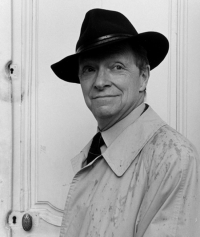
Henri Pousseur 23 June 1929–6 March 2009
Henri Pousseur has recently left us. He was (amongst many other things) an advisory editor of JNMR. And rightly so. His penetrating analyses of the work of many of his colleagues from the Western avant garde and of his own output as a composer may be qualified as RNM—Research on New Music—whereas his writings that consider the whole of music history in its universality as a production of humankind, as if from a bird's (or an Icarus') perspective, certainly represent a perfect specimen of NRM—New Research on Music. His contributions to the disciplines of composition and music theory are numerous and impressive. And they are complementary: composition as the practice of theory, composition and theory as mutually retroactive fields of inquiry, music theory as an expert system for composition, composition as research, as a branch of the science of music.
Taking his lead from serialism, Pousseur went on further to disconnect parameters, putting the complete set of elements of each of them, including their various multiplications with one another, at his command for recombination. Throughout his career, he remained in search of an all-inclusive, integrative compositional method, of which his scores would be instantiations, a ‘universal matrix’.
Ultimately he serializes composite, even multicultural, music-stylistic identities as elements of composition: Musiques Croisées, Couleurs Croisées, Crosses of Crossed Colors—a kind of ‘orchestra of the world’. His work constitutes a vast recomposition of the integral materials of the history of music, read as a proposal to be prolonged by extrapolation, in retrospect and in prospect.
With Pousseur, the act of composition means putting at the disposal of the participant—performer and listener—materials to compose with. The electroacoustic composition Scambi (Studio of the RAI, Milan, 1957), a series of tapes to be combined and recombined at the option of the user, was the prototype of that.
Typically, his own brand of ‘open structure work’ consists of a model for composition and the result(s) of its application: model composition(s). Icare Obstiné (1972) is such a ‘model for’ (‘pro-gram’); Icare Obstiné–Vol no.1 is an instantiation of it, worked and written out by the composer himself. The socio-political implication: ‘musicking’, making music, is here viewed as a micro-model of participative action, social cooperation, solidarity and shared responsibility.
A final example of interfacing is offered by Pousseur's lifelong collaboration with the French author Michel Butor which encompasses ‘intersemiotic translations’, not only Pousseur setting texts by Butor, either pre-existent or elaborated in common, but also Butor contributing verbal texts to pre-existing music by Pousseur. Répons (1960) was a purely instrumental composition, Répons avec son Paysage (1966) is a collaborative effort in which texts by Butor have been specifically grafted upon the instrumental actions of Répons.
Hear Pousseur and read him.